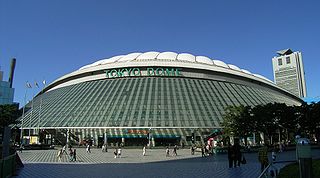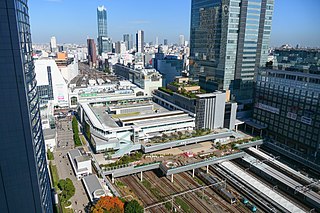
Bunkyō is a special ward located in Tokyo, Japan. Situated in the middle of the ward area, Bunkyō is a residential and educational center. Beginning in the Meiji period, literati like Natsume Sōseki, as well as scholars and politicians have lived there. Bunkyō is home to the Tokyo Dome, Judo's Kōdōkan, and the University of Tokyo's Hongo Campus. Bunkyō has a sister-city relationship with Kaiserslautern in the Rhineland-Palatinate of Germany.

Tokyo Station, also sometimes referred to as Tokyo Central Station, is a railway station in Chiyoda, Tokyo, Japan. The original station is located in Chiyoda's Marunouchi business district near the Imperial Palace grounds. The newer Eastern extension is not far from the Ginza commercial district. Due to the large area covered by the station, it is divided into the Marunouchi (west) and Yaesu (east) sides in its directional signage.

Shinjuku Station is a major railway station in the Shinjuku and Shibuya wards in Tokyo, Japan. In Shinjuku, it is part of the Nishi-Shinjuku and Shinjuku districts. In Shibuya, it is located in the Yoyogi and Sendagaya districts.

The Keiō Line is a 37.9-kilometer (23.5 mi) railway line in western Tokyo, Japan, owned by the private railway operator Keiō Corporation. It connects Shinjuku, Tokyo, with the suburban city of Hachiōji. The Keiō Line is part of a network with interchanges and through running to other lines of Keiō Corporation: the Keiō New Line, Keiō Sagamihara Line, the Keiō Keibajō Line, the Keiō Dōbutsuen Line, the Keiō Takao Line, and the 1,067 mm gauge Keiō Inokashira Line.

Tokyo Dome is an indoor stadium in Bunkyo, Tokyo, Japan. It was designed as a baseball stadium following its predecessor, Korakuen Stadium.

Nihonbashi (日本橋) is a business district of Chūō, Tokyo, Japan which grew up around the bridge of the same name which has linked two sides of the Nihonbashi River at this site since the 17th century. The first wooden bridge was completed in 1603. The current bridge, designed by Tsumaki Yorinaka and constructed of stone on a steel frame, dates from 1911. The district covers a large area to the north and east of the bridge, reaching Akihabara to the north and the Sumida River to the east. Ōtemachi is to the west and Yaesu and Kyobashi to the south.

Oshiage Station is a railway station in Sumida, Tokyo, Japan, jointly operated by Tokyo Metro, Tobu Railway, Toei, and Keisei Electric Railway. It is adjacent to the Tokyo Skytree complex.

Tokyo Dome City, referred to as Big Egg City before January 1, 2000, is an entertainment complex in Bunkyo, Tokyo, Japan.

Nihombashi Station is a subway station in the Nihonbashi district of Tokyo, Japan, jointly operated by Tokyo Metropolitan Bureau of Transportation (Toei) and Tokyo Metro.
The January 4 Tokyo Dome Show is a professional wrestling event produced annually on January 4 in the Tokyo Dome by New Japan Pro-Wrestling (NJPW), a Japan-based professional wrestling promotion. NJPW has promoted events in the venue every January 4 since Super Warriors in Tokyo Dome in 1992.

Komaba-tōdaimae Station is a railway station on the Keio Inokashira Line in Komaba, Meguro, Tokyo, Japan, operated by the private railway operator Keio Corporation.

Korakuen Hall is a sports arena in Bunkyo, Tokyo, Japan, which has hosted boxing, professional wrestling, kickboxing, mixed martial arts and Lethwei matches.

Hatchōbori Station is a railway station in Chūō, Tokyo, Japan, operated by both the Tokyo Metro and the East Japan Railway Company.

Hikawadai Station is a subway station in Nerima, Tokyo, Japan, operated by the Tokyo subway operator Tokyo Metro.

Tokyo Big Sight Station is a station on the Yurikamome Line in Kōtō, Tokyo, Japan. It is numbered "U-11".

Toshimaen Station is a railway station in Nerima, Tokyo, Japan, operated by the private railway operator Seibu Railway and the Tokyo subway operator Toei Subway.

Kōrakuen Station is a subway train station in Bunkyō, Tokyo, Japan, operated by the Tokyo subway operator Tokyo Metro. It is directly connected by an underground pedestrian passage to the Toei-operated Kasuga Station. It is integrated with the Tokyo Dome City complex and the Bunkyō ward capitol building.
The Animax Anison Grand Prix is a Japanese anime song music competition, organized by Animax, in association with Jupiter Telecommunications.

Wrestle Kingdom III in Tokyo Dome was a professional wrestling pay-per-view (PPV) event produced by the New Japan Pro-Wrestling (NJPW) promotion, which took place at the Tokyo Dome in Tokyo, Japan on January 4, 2009. It was the 18th January 4 Tokyo Dome Show and the third held under the "Wrestle Kingdom" name. The event featured eleven matches, five of which were contested for championships. Wrestle Kingdom is traditionally NJPW's biggest event of the year and has been described as their equivalent to WWE's WrestleMania.

Battle Satellite in Tokyo Dome was a major professional wrestling event produced by New Japan Pro-Wrestling (NJPW). The event took place on April 24, 1989 at the Tokyo Dome in Tokyo, Japan. It was the first major professional wrestling event held in the Tokyo Dome, with wrestlers from the United States, Japan, and the Soviet Union.




















